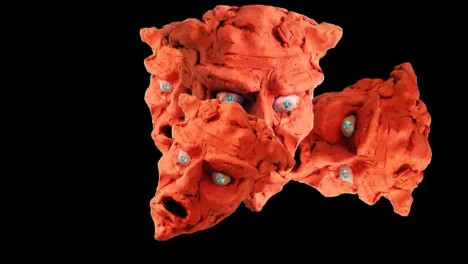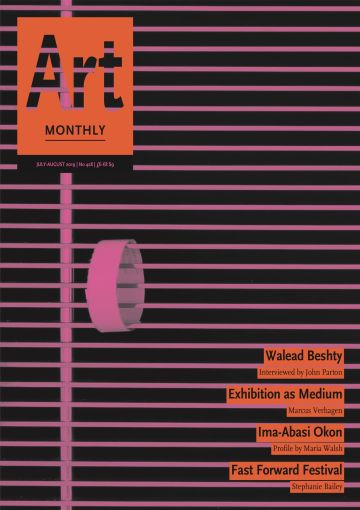Review
Richard Grayson: Possessions_inc.
Jamie Sutcliffe navigates the vortex of superstition and techno-consipiracy in Richard Grayson’s online video series

Richard Grayson Possessions_inc. 2016-19
In 1933 The Eton Review published an uncharacteristically aphoristic essay-turned-short story by the English antiquary MR James. Titled ‘The Malice of Inanimate Objects’, this humorous but chilling text ruminated on the imagination’s propensity for interpreting plain old bad luck as a supernatural conspiracy between ‘things that do not speak’. For James, the collar stud, inkstand, razor blade or loose step were all common articles whose accidental misuse might resound with all the pain and annoyance of a deliberate attack. Skip to the present – to an era defined by the author Shoshana Zuboff as ‘the age of surveillance capitalism’ – and we might recognise the progeny of James’s malevolent objects in the arsenal of networked appliances that comprise the ‘internet of things’, that semi-conscious tracery of domestic infrastructures that converse and conspire behind our backs, eroding our attention and privacy by delivering personal data to private companies or prying hackers.
It is these entwined genealogies of superstition and technological innovation that Richard Grayson brilliantly and often hilariously unravels in his episodic video web series Possessions_inc., which has been broadcast monthly on the Matt’s Gallery website since 2016. Oscillating tonally between the analytical stringency of an artist’s essay film and the batshit prognoses of ‘deep YouTube’ conspiracy fare, Grayson narrates examples of an inorganic infringement on our wellbeing that suggest the co-existence of both a ‘rational’ technophobic fear of intrusion and the ‘irrational’ anxiety (or even hope) of new media providing novel channels for spectral communication. The result is an arch conspiricist’s worldview that constellates the fluctuating auratic function of art objects with the opacity of finance and the uncanny intelligences of emergent tech into a deeply immersive patchwork of anecdotes, hard data and bizarre song.
On the one hand, Grayson tells us the stories of a female consumer whose ‘smart dildo’ fed data concerning her ‘use time’ and ‘intensity preferences’ back to its manufacturer unauthorised, or the case of Brian Krebs, an investigative journalist for the Washington Post whose tenacious reporting on cybercrime led to his ‘smart home’ being hacked and surveilled by criminals who were able to reconfigure his television set into a hostile reconnaissance device. On the other hand, we are told the tale of the ‘Japanese Girl’s Suicide Drawing’, a well known ‘creepypasta’ meme in which the last image created by a young suicide victim supposedly harboured a melancholic spirt that could possess its viewer if gazed upon for too long. The image in question was originally created by the Thai artist Robert Chang, but it exists in Grayson’s apocryphal miscellany alongside the eBay sale of jinxed dolls and instances of otherwise innocuous artworks becoming the subject of internet-age pranks, significantly The Hands Resist Him, 1972, a painting by Bill Stoneham that rose to notoriety after its online auction listing suggested it was cursed. Such stories illustrate a persistent inclination to filter the velocity of technological evolution through the interpretative armature of superstition, a tendency once characterised by cultural historian Jeffrey Sconce as ‘haunted media’ and which has since been further articulated by the writer Erik Davis, who maintains that new technologies do indeed function as a kind of magic, ‘opening up novel and protean spaces of possibility within social reality’.
By giving such stories equal presence, often blurring their content through pitch-shifted vocal manipulation, cacophonous repetition and layering, Possessions_inc. begins to build vertiginous diagnoses in which the interrelationship of art and technology, and specifically their utility within techniques of global finance, strategic inequity and investment, are marked by pronounced fluctuations in faith and paranoia. Grayson isn’t simply asking what happens to the auratic function of art in a free-market economy (a simultaneous process of desacralisation and fetishisation), but how a post-truth milieu in which stories, images and artefacts can be digitally manipulated and reproduced might throw all forms of cultural production and value extraction into a new age of unprecedented indeterminacy and malign interdependency. ‘What do you get if you cross a conceptualist with an accountant?’, Grayson muses acerbically, ‘You get new forms of disembodied value.’
Grayson makes for an endearingly jocular narrator, and it is appropriate that his on-screen proxy takes the archetypal form of Asmodeus, a demon prince of Judeo-Islamic lore whose presence has been crudely animated from a photograph of a sculpture found at the Church of Saint Mary Magdalene in the village of Rennes-le-Château, southern France. This horned avatar has an acute proximity to the potency of deception, and we hear how its rural home has catalysed countless conspiracy theories throughout the 20th century thanks to a prank by Noël Corbu, a local restaurateur, who in the 1950s attempted to bring tourists to the village by suggesting the church concealed treasures of the French crown. This legend would later spiral into its own cosmology after hoaxers Pierre Plantard and Philipe de Chérisey planted forged documents in the Bibliothèque Nationale relating the treasure to a secret society, the Priory of Sion, charged with protecting the bloodline of a Merovingian dynasty. Ventriloquising these hubristic tricksters, Grayson postulates that these ‘codes and magic will work as an analogue for magic in a future that has no magic’, resulting in the destabilisation of the very idea of truth.
The post-truth moment softens the binary between the lucid and the conspiratorial, and Grayson suggests that the resulting pliancy of authenticity works less in the favour of the subaltern than it does those who wish to retain power. His idiosyncratic bricolage of stories implies that tricksterism should not be trusted as the tool of deviancy, dissensus and the rebuilding of the social imaginary that the folklore of the past once promised, but considered as a mechanism of control in which an existing order is perpetuated through the kaleidoscopic propagation of counter-narratives whose secret societies, salacious initiation rituals and bankers’ cabals deflect attention from real economic malpractice. Such heavily mediated mythopoetics leave techniques of interpretation in a potentially impoverished state and, as anthropologist and activist Erica Lagalisse has suggested in her recent book Occult Features of Anarchism, even the most progressive attempts at cognitively mapping the flow of capital are susceptible to finding false forms of stability in racist or bigoted narratives that posit vulnerable groups as the source of our inequalities. Possessions_ inc. provides a modest riposte to this situation, interrogating the texture of conspiracy by inhabiting, mocking and exploding its stories, legend-tripping it into absurdity.
Jamie Sutcliffe is a writer, curator and co-director of Strange Attractor Press.
Visit the Possessions_inc. website: https://possessions-inc.mattsgallery.org
First published in Art Monthly 428: Jul-Aug 2019.











